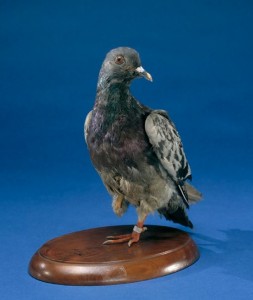Spy Pigeons
Unlikely soldiers during World War II: more than 250,000 pigeons were deployed by the British
/https://tf-cmsv2-smithsonianmag-media.s3.amazonaws.com/filer/c1/f5/c1f50e84-88c4-4432-ac79-22b782d82bc6/pigeons-conversing1.jpg)
When World War II broke out, Britain was gripped by “Fifth Column Neurosis,” an almost universal belief that the country was riddled with enemy spies, not all of them human. Ben MacIntyre writes in the wonderful Double Cross: The True Story of the D-Day Spies (Crown, 2012), “When six cows stampeded on the tiny island of Eilean Mor in the Scottish Hebrides, this was immediately ascribed to secret enemy activity. That the spies were invisible was merely proof of how fiendishly clever they were at disguising themselves. Even pigeons were suspect, since it was widely believed that enemy agents had secret caches of homing pigeons around the country that they used to send messages back to Germany.”

Cher Ami, awarded the French Croix de Guerre, died of his wounds in 1919. His taxidermied remains are on display at the Smithsonian Museum of American History.
Pigeon paranoia was actually a logical response. More than 100,000 pigeons flew missions in World War I, including the heroic Cher Ami, a Black Check cock carrier pigeon, part of the U.S. Army Signal Corps in France. Cher Ami delivered 12 important messages within the American sector at Verdun. On his last mission, on October 4, 1918, he was shot through the breast and leg, but still managed to deliver his message—which saved 194 troops of Major Charles S. Whittlesey’s “Lost Battalion.”
During World War II, some 250,000 pigeons were deployed by the British, part of a special section of MI5 headed by Flight Lieutenant Richard Melville Walker. Walker was convinced, says author MacIntyre, “that Nazi pigeons were…pouring into Britain, by parachute, high-speed motor launch, and by U-boat.” The anti-avian frenzy was so extreme that “Some experts claimed to be able to identify a pigeon with a German ‘accent.’ ”
“Animal-based espionage and sabotage was all the rage among Allied plotters,” explains MacIntyre. British Special Operations Executive agents stuffed dead rats with explosives, while the Americans worked on a plan to attack Japan using Mexican bats carrying incendiaries. But Flight Lieutenant Walker, who “flourished in that gray area between ingenuity and insanity,” says MacIntyre, gets top honors for his Pigeon Contamination Plan.
Walker disguised hundreds of British pigeons as German pigeons (by decking them out with forged leg rings and counterfeit German wing markings), and sent them off to infiltrate and take down the German war machine from within. The plan was a bust, says MacIntyre: “The Germans never detected the double-agent pigeons in their midst.”
Avian spies are still among us. In May 2010, police in Punjab, India, arrested a pigeon believed to be spying for Pakistan. (The bird was kept under armed guard in a special air-conditioned room and refused visitors.) In January 2011, Saudi Arabian officials detained a vulture, stating it was an unwitting Mossad operative. And on December 10, 2012, Sudanese officials in the Darfur region of Sudan arrested a vulture, alleging it was on a surveillance mission for Israel. (The bird’s leg tag was marked “Israel Nature Service” and “Hebrew University, Jerusalem.”)